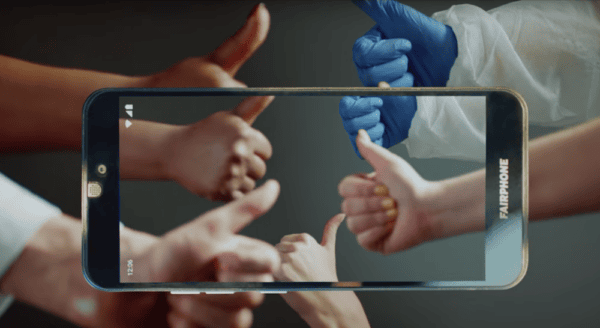
[Image above] As Right to Repair legislation gains traction in government, some companies—like Fairphone—are pursuing easily repairable and environmentally friendly devices on their own. Credit: Fairphone, YouTube
Although I like my Kia, I still think fondly of my first car, a 2001 Buick LeSabre. For seven years that car taught me the intricacies of parallel parking, the blessing of heated seats—and the importance of building a good relationship with your mechanic.
Being a 2001 model, the car frequently needed repairs, from the mass airflow sensor to the drive belt. I was fortunate to meet an outstanding mechanic who not only fixed my car at great prices but also took me into the shop to show how things were replaced.
Seeing my Buick repaired by a professional gave me a deep appreciation for the knowledge mechanics must have today to fix vehicles. Gone are the days when you could pop open the hood and see the ground—now even a simple jump start requires careful, precautionary preparation (or a professional auto technician).
The complexity of modern cars—and modern electronic devices in general—has led to an increasingly vocal “Right to Repair” movement.
The basis for the Right to Repair movement is simple—give consumers the ability to repair their own devices. Today, manufacturers rarely provide consumers or independent repair shops access to the service information, spare parts, special tools, and repair software necessary to fix a device, whether a smartphone or a car. And if consumers fix a device on their own, the manufacturer may claim the warranty is void.
(Technically, the Magnuson-Moss Warranty Act of 1975 makes it illegal for companies to void a warranty just because a customer repaired or modified the device themself, but few people have the resources to sue large manufacturers over voided warranties in court.)
The Right to Repair movement has gained steam this past year in government, with 20 states considering Right to Repair bills this legislative cycle and some presidential candidates making it part of their platform. These bills mainly focus on dismantling the monopoly large manufacturers have on the repair market. Yet behind the scenes, startup companies aim to make the market fairer on their own.
Such as Fairphone.
Fairphone is a social enterprise company that aims to design, develop, and produce smartphones with minimal environmental impact that are easily repaired. The company started as an awareness campaign in 2010 to educate people on conflict minerals in consumer electronics and the wars fueled by mining these minerals in the Democratic Republic of the Congo.
Fairphone released its first phone, the Fairphone 1, in 2013. Their newest phone, the Fairphone 3, will ship in late October.
Fairphone’s goal is to create smartphones that are sustainable on all levels, from the supply line to the device to end-of-life disposal. See some of the ways they accomplish this goal below.
Supply line
In an effort to embrace transparency, the Fairphone website features a list of suppliers that supply materials for Fairphone smartphones. Additionally, the website’s blog features articles describing how materials are sourced ethically, such as gold in Uganda, and how worker rights are protected and improved, for example, the Worker Welfare Fund.
Device design
Fairphone smartphones are constructed out of modules that can be easily taken apart and reassembled. This approach to simple repairability appears to work well—iFixit, a wiki-based site that teaches people how to fix things, gave the Fairphone 2 the website’s first 10/10 repairability score for a phone.
The Fairphone website provides a place to buy spare parts whenever a module fails. (However, if you own a Fairphone 1, you may be out of luck.)
Recycling
For Fairphone, the goal is not just to create an easily repaired, environmentally friendly phone. They envision the smartphone industry as a circular economy, in which smartphones are recycled into other uses at the end of their life.
To help achieve a circular smartphone economy, Fairphone runs a cash-back recycling program on its website. The collected smartphones are then reused and recycled into other things. For example, the plastic cases are sent to Amsterdam-based upcycling startup vanPlestik to be used as raw material for its 3D printers.

The Fairphone 3 consists of seven modules that can be easily disassembled and put back together—a true example of a Right to Repair device! Credit: Fairphone, YouTube
By ethical sourcing of materials, simple design construction, and reuse of discarded devices, Fairphone minimizes the environmental impact of smartphones in multiple ways, in addition to supporting the Right to Repair movement.
Because of Fairphone’s prioritization of sustainability, Fairphone smartphones are not competitive with other flagship smartphones in terms of device specifications (e.g., camera and processor). However, an article on The Verge notes that Fairphone’s specifications are still, unsurprisingly, fair.
“[The Fairphone 3 has] got a 5.7-inch Full HD display, a 12-megapixel rear camera, and an 8-megapixel front-facing camera,” the article describes. “Internally the phone is built around a Qualcomm Snapdragon 632 processor, and features 4GB of RAM and 64GB of internal storage. Its 3,000 mAh battery might not be the biggest around, but it’s removable, allowing you to easily replace it if its capacity starts to degrade.”
Take a look at the new Fairphone 3 in the video below!

Credit: Fairphone, YouTube
Author
Lisa McDonald
CTT Categories
- Electronics
- Environment
Spotlight Categories
- Member Highlights


